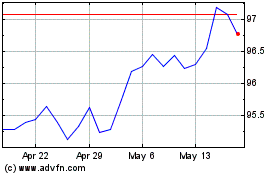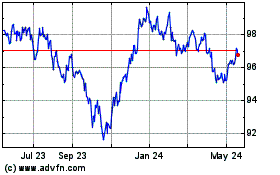Time for the Convertible Bond ETF? - ETF News And Commentary
April 03 2013 - 6:15AM
Zacks
Given the current ultra-low yield environment and fears of
interest rate hikes later this year or next, investors are
searching for a safe and higher level of income with lower downside
risk. One such area is the convertible bonds space which provides
investors with some of the benefits of bonds as well as stocks.
What are Convertible Bonds?
Convertible bonds are those that can be exchanged at the option
of the holder, for a specific number of preferred or common
shares.
Like traditional bonds, convertible bonds are issued at par, pay
fixed coupons and have fixed maturities. The main difference is
that convertible bonds offer investors the right to convert their
bond holdings into a company’s shares at the holder’s
discretion.
This allows investors the potential to play both sides of a
company — debt and equity — in a single security offering a lower
risk choice (read: Time for Inverse Bond ETFs?).
The price of these bonds generally moves in-line with the
underlying shares. However, unlike shares, convertible bonds have
some downside protection since investors can redeem them at par on
maturity as long as the issuer remains solvent.
And in the event of bankruptcy, convertible bond holders have
a higher claim than the common shareholders on the company’s
assets. This suggests that convertible bond holders could do better
than their equity counterparts in such a situation.
Convertible Bond ETF in Focus
Investors seeking capital appreciation with a steady flow of
income and lower downside risk can play with the only pure option
in the space — SPDR Barclays Capital Convertible Securities
ETF (CWB). The fund
tracks the Barclays U.S. Convertible Bond > $500MM Index, before
fees and expenses.
The ETF holds 99 securities with average maturity of 10.28
years. The product is quite spread out across individuals as it
puts just 27% of the assets in the top 10 holdings. Securities from
Wells Fargo (WFC), General Motors (GM) and Bank of America (BAC)
occupy the top three positions in the basket.
The fund has heavy investments in the technology sector while
consumer non-cyclical and finance occupy the next two spots (read:
Three Tech ETFs Still Going Strong).
The product is heavily tilted towards intermediate term
securities as those that mature in 5 years and before account for
roughly 63% of the assets. In terms of credit quality, the fund has
a tilt towards low quality bonds, as Baa and lower rated securities
account for 88% of the assets (see more in the Zacks ETF
Center).
CWB charges 40 bps in fees a year from investors. In addition,
it trades in a good volume of more than 250,000 shares per day,
ensuring a relatively tight bid/ask spread. Further, the fund
gathered over $116.0 million in assets in the first quarter of the
year, reaching $1.1 billion in AUM since its inception in April
2009.
In terms of performance, investors should note that the product
has shown resilience, with an upward trend in the second half of
the last year. This positive trend has followed well into 2013,
with a more than 4% gain year-to-date.
The fund pays a solid 3.02% in annual dividend yield and 2.13%
in 30-day SEC yield. While these yields may be lower than the
traditional bond counterparts, it is higher than the dividend yield
of the underlying common stocks (read: Two Unconventional Sources
of ETF Yield).
Further, CWB has outpaced traditional bond counterparts by wide
margins but underperformed broad equity ETFs (such as SPY). This
suggests that the ETF could be an interesting pick for investors
seeking exposure to the fixed income market, while still partaking
in a bit of the equity rally.
Want the latest recommendations from Zacks Investment Research?
Today, you can download 7 Best Stocks for the Next 30
Days. Click to get this free report >>
ISHARS-BR AG BD (AGG): ETF Research Reports
VANGD-TOT BOND (BND): ETF Research Reports
SPDR-BC CONV SC (CWB): ETF Research Reports
SPDR-SP 500 TR (SPY): ETF Research Reports
To read this article on Zacks.com click here.
Zacks Investment Research
Want the latest recommendations from Zacks Investment Research?
Today, you can download 7 Best Stocks for the Next 30 Days. Click
to get this free report
US Aggregate (AMEX:AGG)
Historical Stock Chart
From Mar 2024 to Apr 2024

US Aggregate (AMEX:AGG)
Historical Stock Chart
From Apr 2023 to Apr 2024
